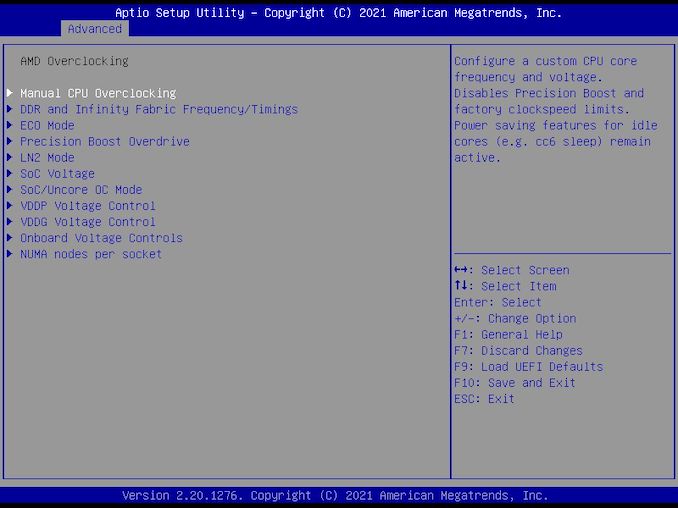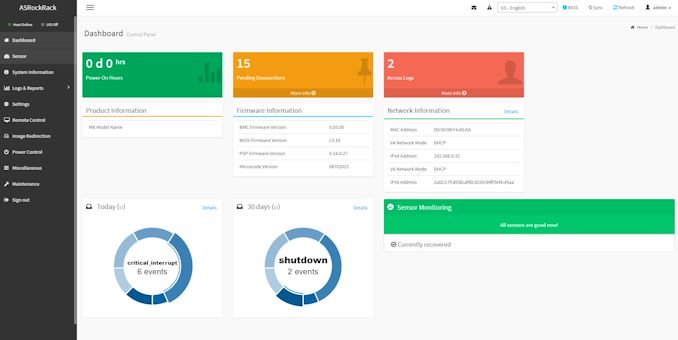ASRock Rack B550D4-4L Motherboard Review: B550 Goes Professional with BMC
by Gavin Bonshor on May 20, 2021 9:00 AM ESTBIOS
ASRock Rack is using an American Megatrends Aptio based firmware for the B550D4-4L. The design of the firmware is basic, with a royal blue framing, and grey background. It's an archaic aesthetic, but it is geared more towards commercial users than providing flashy GUI's from that of consumer desktop models.
Pressing the Del key allows users to enter the BIOS, and the first screen users will see is the Main section. This section displays information about the installed processor, cache sizes and specification, as well as system memory installed and the relevant speeds. At the right-hand side, there's a hotkey list that includes basic information on what each hotkey does, eg, F1 for the help menu, F7 to discard any changes made in the firmware, F9 to load the board's UEFI default settings, and F10 to save and exit the BIOS.
Despite its professional-level functionality with support for both non-ECC and ECC memory which is consistent with server and workstation usage, as the B550D4-4L is based on the AMD B550 chipset, it does officially support overclocking. The board's overclocking settings primarily come from the platform, with very antiquated levels of settings available for users. Generally speaking, while the B550D4-4L supports overclocking, both manually and with AMD's Precision Boost Overdrive, it's not recommended to push the processors too much for a couple of reasons. The first is the 4+2 power delivery isn't considered very premium, and they are typically built to specification for these types of boards without any overcompensation of componentry. The second is the power delivery heatsinks aren't capable of holding a consistent level of heat, due to their size, overall mass, and positioning on the board. Users are more than welcome to overclock on this model to their heart's content, but we simply wouldn't recommend it for the reasons stated above.
A lot of the firmware functionality revolves around professional elements, such as security, power management, and BMC control. Configuration of the BMC can be done within the Server Management section and allows users to create custom IP addresses so the system can be accessed over a network. Overall the firmware on the ASRock Rack B550D4-4L is functional but without the glitz and glamour of desktop models. It is responsive to USB keyboards and mice and provides everything users need to get server-focused systems up and running.
Software
The ASRock Rack B5504D-4L doesn't come supplied with any software as such, but it does include an ASPEED AST2500 BMC controller, which can be accessed remotely via a single Realtek RTL8221E Gigabit Ethernet port on the rear panel. Setting up the BMC IP address within the firmware is easy enough for an experienced user, but for amateur users, there are plenty of guides available online.
The ASRock Rack IPMI can be accessed by inputting the IP address and settings set within the BMC section of the firmware. The usual method of logging into the IPMI is with a predefined set of credentials, in this case with the username and password, admin/admin.
New legislation via Senate Bill No. 327, under California Law which was passed in 2018, states that each device comes supplied with unique credentials for each individual device. Technically, ASRock Rack is in breach of this law which means that the B550D4-4L wouldn't be permitted to be sold within California.
Upon logging in for the first time, the IPMI does request that users create a new password that could be considered a circumvention of the law, but we aren't legal experts by any stretch and as such, don't want to speculate on this.
The ASRock Rack IPMI is very functional, informative, and uses a clean-cut GUI. One of the highlights of the GUI is in the dashboard, which provides critical information on power uptime, critical interrupt errors, and any shutdown errors encountered on the system. It also provides information on overall sensor health through sensor monitoring. Any errors or anomalies, or any sensors operating with temperatures or voltages outside of common parameters, will be displayed on the dashboard. The ASRock Rack IPMI also provides many different functions, including a comprehensive sensor monitoring page, a KVM viewer with HTML5 and Java variants for users to utilize, as well as control of power settings, such as powering up or down the system remotely. This also stretched to typical maintenance elements such as updating the firmware of the board remotely and backing up system data.
Overall ASRock Rack's IPMI interface is one of the better ones we've used in recent years and provides more than enough functionality when combines with the ASPEED AST2500 BMC controller and Realtek RTL8211E Gigabit Ethernet remote access point.


























73 Comments
View All Comments
im.thatoneguy - Thursday, May 20, 2021 - link
Please stop putting 10g ports one servers.They're always 10-BaseT which is useless to me. They take up pcie lanes. And 25gb/40gb/100gb is imminently supplanting 10gb.
It's too late for 10g especially baseT
fmyhr - Thursday, May 20, 2021 - link
Heh. I agree with you about 10-BaseT, SFP+ would be preferable if 10GbE *needs* to be present. I don't have $ or power budget for 25gb/40gb/100gb network... but understand those are requirements for some. I'm curious how your ideal board would allocate its limited PCIe lanes among PCIe slots, M.2 slots, OcuLink,...?bananaforscale - Saturday, May 22, 2021 - link
10GBase-T uses the same cabling as 1000Base-T, assuming the network was built with any future proofing so you can basically just plug it in. 25GBase-T probably won't happen. 'sides, YOU are not the market. What's useless to you is probably useful for someone. Also besides, you can disable those integrated NICs.mode_13h - Saturday, May 22, 2021 - link
> 10GBase-T uses the same cabling as 1000Base-T,> assuming the network was built with any future proofing
Depends on when. It might've been built with Cat 6, rather than Cat 6A. And even that has shorter length limitations and requires greater power expenditure than we're used to with Gigabit.
BTW, there's no such standard as Cat 6e. If you see someone selling cable as Cat 6e, treat it as plain Cat 6, but with a bit more suspicion.
Samus - Thursday, May 20, 2021 - link
I think 2x2.5G would be more appropriate for the target market of this board. Anybody considering 10Gbe is likely on the verge of adopting 25/40/100G anyway, in which case the PCIe slot will be utilized.The other head scratcher is why the M2 slot isn’t PCIe 4.0 - the allocation of PCIe lanes to ports on this board is very strange.
fmyhr - Thursday, May 20, 2021 - link
Do you have personal experience running 2.5GbE? I've seen reports of problems using both Intel and Realtek chipsets. Whereas 10GbE is very mature and well-supported. Upside of being "obsolete" :-)This board runs the M.2 slot from the B550 chipset, which limits its speed to PCIe 3.0. The upside of this choice is an extra PCIe 4.0 x4 slot from the CPU. Into which you could install an M.2 carrier board if you need your SSD on PCIe 4.0. Personally I'd try bifurcating the PCIe 4.0 x16 slot and running a quad M.2 card there, and whatever other PCIe card in the x4 slot.
lightningz71 - Thursday, May 20, 2021 - link
Does this board even support 4way bifurcation of the PCIe x16 slot?Samus - Friday, May 21, 2021 - link
The B550 can't bifurcate the x4 slot, but it apparently can the x16 slot. In the case of some boards with multiple PCIe 4.0 NVMe M.2 connectors, they start by cutting the x16 slot bandwidth, then after a third M.2 drive is installed they either totally disable the x4 slot or run the x16 slot at x4, configurable in the BIOS (in the case of the Gigabyte B550 Aurus Master)Samus - Friday, May 21, 2021 - link
Personally no I'm not running any 2.5G stuff, and based on what you are stating, maybe that's why there hasn't been adoption. I agree going with a mature solution but 2.5G isn't exactly new and by now you'd think the bugs are worked out. 2.5G is, after all, based on a lower handshake of 10Gbe, and at long distances 10Gbe actually negotiates at 2.5G, and I have installed 2.5G cards in the field that connect to 10Gbe ports at 2.5G. It's the damn SFP adapters that are all proprietary with their individual standards so you just need to make those up with whatever chipset the NIC you are connecting has.Regarding NVMe on B550, I'm not sure what you are getting at. There have been B550 boards on the market for over a year that have not one, not two, but three native PCIe4 NVMe M.2 slots direct from the chipset. Obviously having many M.2 slots impedes on other PCIe x4\x8\x16 slot bandwidth because the consumer Ryzen's don't offer many lanes. But that doesn't mean this board should leave support out entirely as the M.2 could just cut into the x4 or x16 slot bandwidth.
mode_13h - Friday, May 21, 2021 - link
> Do you have personal experience running 2.5GbE?Well, the main benefit is cable length and compatibility. If the speed is fast enough for you, then it seems an attractive option for those with legacy cabling.